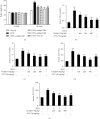Catalpol Attenuates Hepatic Steatosis by Regulating Lipid Metabolism via AMP-Activated Protein Kinase Activation
- PMID: 32420361
- PMCID: PMC7201822
- DOI: 10.1155/2020/6708061
Catalpol Attenuates Hepatic Steatosis by Regulating Lipid Metabolism via AMP-Activated Protein Kinase Activation
Abstract
The increased prevalence of nonalcoholic fatty liver disease (NAFLD), which develops from hepatic steatosis, represents a public health challenge. Catalpol, a natural component extracted from the roots of Radix Rehmanniae, has several pharmacological activities. The present study is aimed at examining whether catalpol prevents hepatic steatosis in cell and animal experiments and elucidating the possible mechanisms. HepG2 cells were treated with 300 μM palmitate (PA) and/or catalpol for 24 h in vitro, and male C57BL/6J mice fed a high-fat diet (HFD) were administered catalpol for 18 weeks in vivo. The results revealed that catalpol significantly decreased lipid accumulation in PA-treated HepG2 cells. Moreover, catalpol drastically reduced body weight and lipid accumulation in the liver, whereas it ameliorated hepatocyte steatosis in HFD-fed mice. Notably, catalpol remarkably promoted the phosphorylation of AMP-activated protein kinase (AMPK) and acetyl-CoA carboxylase. Subsequently, catalpol repressed the expressions of lipogenesis-associated genes such as sterol regulatory element-binding protein 1c and fatty acid synthase but promoted the expressions of genes associated with fatty acid β-oxidation such as peroxisome proliferator-activated receptor α together with its target genes carnitine palmitoyltransferase 1 and acyl-CoA oxidase 1 (ACOX1). However, the preincubation of the HepG2 cells with compound C (10 μM), an AMPK inhibitor, prevented catalpol-mediated beneficial effects. These findings suggest that catalpol ameliorates hepatic steatosis by suppressing lipogenesis and enhancing fatty acid β-oxidation in an AMPK-dependent manner. Therefore, catalpol has potential as a novel agent in the treatment of NAFLD.
Copyright © 2020 Xiang Tian et al.
Conflict of interest statement
The authors have no conflict of interest to declare.
Figures






References
-
- Heeba G. H., Morsy M. A. Fucoidan ameliorates steatohepatitis and insulin resistance by suppressing oxidative stress and inflammatory cytokines in experimental non-alcoholic fatty liver disease. Environmental Toxicology and Pharmacology. 2015;40(3):907–914. doi: 10.1016/j.etap.2015.10.003. - DOI - PubMed
MeSH terms
Substances
LinkOut - more resources
Full Text Sources

